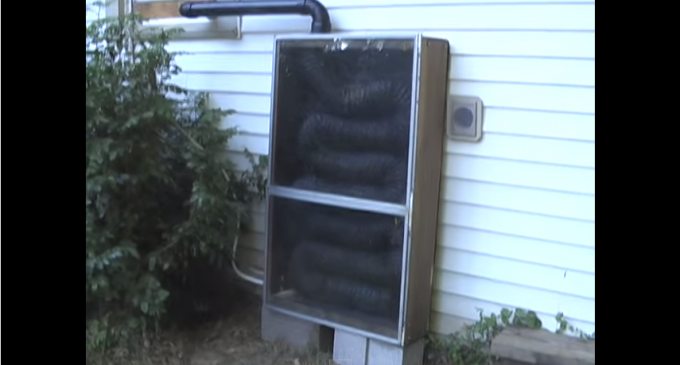
A simple solar heater that is cheap and easy to make. When there is direct sun on the unit it produces heat like a hair dryer.
According to the creator it produces a stream of air of around 120 degrees.
Some suggested tips for improvement:
– Make sure your black paint is matte so it doesn’t reflect the sun.
– The air moves by convection, however, you could add a small computer fan on the outlet and wire it to a 12 volt solar cell the unit to control the air rate.
– The intake size could be adjusted to control air rate as well. Making the intake smaller will give the air time to heat up while passing through the dryer ducting but it will slow down the rate of air flow. You can run it hot and slower or with more air and not as warm.
– A flat plate could be added between the intake tube and inside wall up to a little pulley inside the house. You could then adjust the air rate like this as well and have an on/off option.
– Add insulation to help maintain heat running through the system. Could prove vital for very cold areas.


Heat is rarely an issue around my domicile. My wife keeps the house around 64 degrees year round. I have to go outside in south Texas just to thaw my hands and feet out.
Explain to me how this helps in the middle of winter? When covered with snow and overcast. Good on yeah. Bet it works great in the summer
Depends on where you live. Here in Colorado, it can be 10 degrees and sunny almost all day. I imagine it would work just fine on days like that.
faget!
Barry would this work?
Yes these types of devices work. If you live in an area that gets snow, but also receives cloudless days between storms, these put out the heat. A guy in Finland uses a “beer can” unit, for most of the heat in his cabin. A design using only “black window screen” is even more efficient. If you live in Western Washington, forget it.
Donald Griswold
Interesting.
Yes Alex these work with some limitations as mentioned by others. These air boxes can work great in garages or seasonal porches in cold climates and room heaters in less insulated homes in warmer climates. Better, more effective solutions heat and store large quantities of hot water. See the works of John Canivan.
Would it be good for a greenhouse?
How long before the federal government puts an end to it?